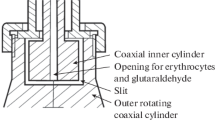Abstract
The aggregation capacity of human erythrocytes lies between that of the non-aggregating bovine erythrocytes and the remarkably aggregating equine ones. As the ability to aggregate is attributed to cell factors and the composition of the plasma proteins, the role that plasma proteins play in the aggregation process in these three species was studied. Washed erythrocytes were suspended in phosphate-buffered saline (PBS; pH 7.4, 300 mOsm/L) plus polyvinylpyrrolidone (PVP) in a suitable concentration to obtain an average intensity of aggregation (control media). The superimposed effect of replacing 80% of the medium by either autologous plasma, serum or albumin solution was studied. The plasma proteins appeared to enhance aggregation by human and equine erythrocytes, but impaired this process in bovine erythrocytes. Some evidence was obtained supporting the existence of serum factors capable of reducing aggregation of erythrocytes in cattle and it was concluded that the non-aggregating behaviour of bovine erythrocytes may be due to the cells interacting particularly with the macromolecules in the serum.
Similar content being viewed by others
REFERENCES
Allen, B.V., 1988. Relationships between the erythrocyte sedimentation rate, plasma proteins and viscosity, and leukocyte counts in thoroughbred racehorses. The Veterinary Record, 122, 329-332
Amin, T.M. and Sirs, J.A., 1985. The blood rheology of man and various animal species. Quarterly Journal of Experimental Physiology, 70, 37-49
Arocha-Piñango, C.L., Diaz de Rodriguez, S., Carrajal, Z. and Gaudens de Fragachán, L. Metodologia. In: Kordich, L., Sánchez Avalos, J.C. and Vidal, H. (eds), Manual de Hemostasia y Trombosis, Argentina, 1990, (Imprenta de la Federación Bioquímica de la Provincia de Buenos Aires), 285-286
Bertoluzzo, S.M., Bollini, A., Rasia, M. and Raynal, A., 1999. Kinetic model for erythrocyte aggregation. Blood Cells, Molecules and Diseases, 25, 338-348
Bollini, A., Rasia, M., Toro, R., Figge, M. and Rocha, D., 2000. Instrumento para medición de agregación eritrocitaria. Revista Argentina de Bioingeniería, 6, 54-70
Chien, S., 1975. Biophysical behaviour of red cells in suspensions. In: D.M. Surgenor (ed.), The Red Blood Cells, (Academic Press, New York), 1031-1133
Chien, S., Usami, S., Dellenback, R.J. and Bryant, C.A., 1971. Comparative hemorheology — hematological implications of species differences in blood viscosity. Biorheology, 8, 35-57
Ditzel, I., 1959. Relationship of blood protein composition to intravascular erythrocyte aggregation (slugged blood). Clinical and experimental studies. Acta Medica Scandinavica (Suppl), 343, 11-63
Janzen, J. and Brooks, D.E., 1989. Do plasma proteins adsorb to red cells? Clinical Hemorheology, 9, 695-714
London, M., 1997. The role of blood rheology in regulating blood pressure. Clinical Hemorheology and Microcirculation, 17, 93-106
Maeda, N. and Shiga, T., 1986. Opposite effect of albumin on the erythrocyte aggregation induced by immunoglobulin G and fibrinogen. Biochimica et Biophysica Acta, 855, 127-135
Muralidharan, E., Tateishi, N. and Maeda, N., 1994. Simultaneous influence of erythrocyte deformability and macromolecules in the medium on erythrocyte aggregation: a kinetic study by a laser scattering technique. Biochimica et Biophysica Acta, 1194, 255-263
Nash, G.B., Wenby, R.B., Sowemino-Coker, S.O. and Meiselman, H.J., 1987. Influence of cellular properties on red cell aggregation. Clinical Hemorheology, 7, 93-108
Ohta, K., Gotoh, F, Tomita, M., Tanahashi, N., Kobari, M., Shinohara, T., Terayama, Y., Mihara, B. and Takeda, H., 1992. Animal species differences in erythrocyte aggregability. American Journal of Physiology (Heart and Circulatory Physiology), 262, H1009-H1012
Rampling, M.W. and Martín, G., 1992. Albumin and rouleaux formation. Clinical Hemorheology, 12, 761-765
Reinhart, W.H., Singh, A. and Straub, W., 1989. Red blood cell aggregation and sedimentation: the role of the cell shape. British Journal of Haematology, 73, 551-556
Reinhart, W.H. and Nagy, C, 1995. Albumin affects erythrocyte aggregation and sedimentation. European Journal of Clinical Investigation, 25, 523-528
Rojkin, M., Olguín, M., Drappo, G. and Sosa, C., 1974. Proteínas totales del suero. Bioquímica del Atlántico, 63, 1931-1954
Seaman, G.V.F. and Uhlenbruck, G., 1963. The surface structure of erythrocytes from some animal sources. Archives of Biochemistry and Biophysics, 100, 493-502
Sewchand, L.S. and Canham, P.B., 1978. Modes of rouleaux formation of human red blood cells in polyvinylpyrrolidone and dextran solutions. Canadian Journal of Physiology and Pharmacology, 57, 1213-1222
Shiga, T., Imaizumi, K., Harada, N. and Sekiya, M., 1983. Kinetics of roleaux formation using TV image analyzer. I. Human erythrocytes. American Journal of Physiology (Heart and Circulatory Physiology), 245, H252-H258
Sowemimo-Coker, S.O., Whittingstall, P., Pietsch, L., Bauersachs, R.M., Wenby, R.B. and Meiselman, H.J., 1989. Effects of cellular factors on the aggregation behavior of human, rat and bovine erythrocytes. Clinical Hemorheology, 9, 723-737
Stoltz, J.F. and Donner, M., 1987. Hemorheology: importance of erythrocyte aggregation. Clinical Hemorheology, 7, 15-23
Tanahashi, N., Gotoh, F., Tomita, M., Shinohara, T, Terayama, Y., Mihara, B., Ohta, K. and Nara, M., 1989. Enhanced erythrocyte aggregability in occlusive cerebrovascular disease. Stroke, 20, 1202-1207
Tomita, M., Gotoh, F, Tanahashi, N. and Turgani, P., 1986. Whole blood red blood cell aggregometer for human and feline blood. American Journal of Physiology (Heart and Circulatory Physiology), 251, H1205-H1210
Weng, X., Cloutier, G, Pibarot, P. and Durand, L.G, 1996. Comparison and simulation of different levels of erythrocyte aggregation with pig, horse sheep, calf, and normal human blood. Biorheology, 33, 365-377
Wessels, J.M.C. and Veerkamp, J.H., 1973. Some aspects of the osmotic lysis of erythrocytes. III. Comparison of glycerol permeability and lipid composition of red blood cell membranes from eight mammalian species. Biochimica et Biophysica Acta, 291, 190-196
Williams, A.R., 1973. The effect of bovine and human serum albumin on the mechanical properties of human erythrocyte membranes. Biochimica et Biophysica Acta, 307, 58-64
Yamamoto, M., 1986. Effects of fibrinogen, globulin, albumin and hematocrit on the kinetics of erythrocyte aggregation in man. Angiology, 37, 663-671
Author information
Authors and Affiliations
Rights and permissions
About this article
Cite this article
Spengler, M., Rasia, M. Influence of Plasma Proteins on Erythrocyte Aggregation in Three Mammalian Species. Vet Res Commun 25, 591–599 (2001). https://doi.org/10.1023/A:1017981301328
Issue Date:
DOI: https://doi.org/10.1023/A:1017981301328



